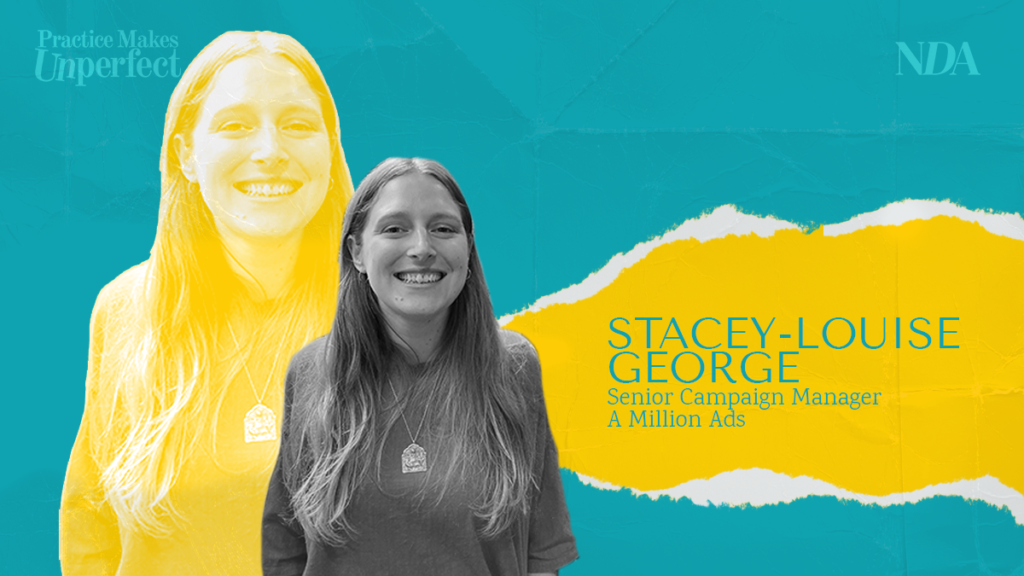These podcasts have been recorded with the latest cohort of the Practice Makes UnPerfect programme – a course that helps women find and finesse their public voices.
By Stacey-Louise George, Senior Campaign Manager, A Million Ads
A lot goes into getting a campaign off the ground, and there are multiple costs that an adtech company will insist upon, like tech fees, production costs and brand lift studies.
Alongside these fees, what if we explored the emotional cost, and let our clients pick up the tab for the emotional energy spent?
It may sound ridiculous, but human beings have an extensive range of emotions (up to 27 if not more!) and are likely to feel a range of these – sometimes to significant extents – throughout a campaign period. According to an HSE study: “In 2019/20 stress, depression or anxiety accounted for 51% of all work-related ill health cases and 55% of all working days lost due to work-related ill health.” Of course, there’s positive emotions as well. If we really love our jobs, those feelings of exhilaration, joy or accomplishment can be felt, leading to a blurred emotional boundary between work and our lives outside.
So if we were to put together a formula, to really put a cost against it, let’s explore what we would need to include.
Burnout
None of us is working in a Victorian cotton mill, yet as explored by Anne Helen Paterson in her Buzfeed article ‘How Millennials Became the Burnout Generation’: “The more we work, the more efficient we’ve proven ourselves to be.” This is where in the modern day we have shot ourselves in the foot; we judge ourselves on our productiveness and therefore crave production. So where do we need to draw the fiscal line before someone becomes burnt out and it affects their health?
A consistent theme I’ve seen from working in various client services, account management and campaign management roles over the years, is that it’s expected to “get shit done and get it done quickly” – a churn designed to squeeze as much out of that person as possible.
Time and time again I have found myself rapidly getting sucked into the drama of panicky client requests and letting issues leak into my evenings and weekends, lingering over me like a foul smell. It’s almost an innate need to “fix” the problem or shouldering the emotional burden of our teammates or clients, constantly thinking how I can “make it better”? And yes, this is incredibly important for being able to increase the number of campaigns, media plans or projects that are being pushed through; however, there still needs to be a human element, too.
Presenteeism
A study run by Vitality in 2020 showed that “British businesses lost an average of 38 working days per employee to physical and mental health-related absence and presenteeism in 2019”. How many times have we tried to be martyrs at work, keeping calm and carrying on?!
As our emotional states feed into our productivity we need to realise that human beings are cyclical creatures – menstruating people even more so. Once again this is something that should be respected and honoured and on occasion, there’s a need to be “on” all the time, especially if you’re in client facing roles. All of us have our own circadian rhythm, which we love to ignore; however, this is something that has been honoured within many ancient practices such as Ayurveda. This awareness has existed for thousands of years and yet, we’re still unable to embrace our natural rhythm within the workplace.
The Virtual Barrier
Video call fatigue has been something that we’ve had to embrace during the past 18 months. As humans, we naturally rely on emotional cues such as body language, facial expressions and even the energy of that person to respond to a person or a situation. This is difficult to do virtually when there’s the barrier of a screen between you and the person you’re talking to. This leads to those visual cues being lost if a camera is turned off and the energy that you gauge from that person in the flesh is also missing – on occasion, leading to hairy situations being misinterpreted. The cost of this fatigue and the zoom anxiety hangover is added to our emotional invoice.
So what if we did measure the cost?
I love a good metric. I love a good formula. So here’s a simple one to keep in your back pocket:
Client spend / (burnout + number of days worked whilst ill + energy spent on endless video calls) = EMOTIONAL COST
At a basic level I feel this would shed light on the emotional energy that we pour into our roles as boundaries between the work/life balance begin to dissolve. And what are the benefits of those in client facing ops roles showing up as the wonderful human beings we all are?
The need for our own emotional awareness is paramount for our self preservation but also leads to the ability to read the emotions of our clients (whoever they may be). An emotional cost at work is inevitable. But how much are you willing to pay?









